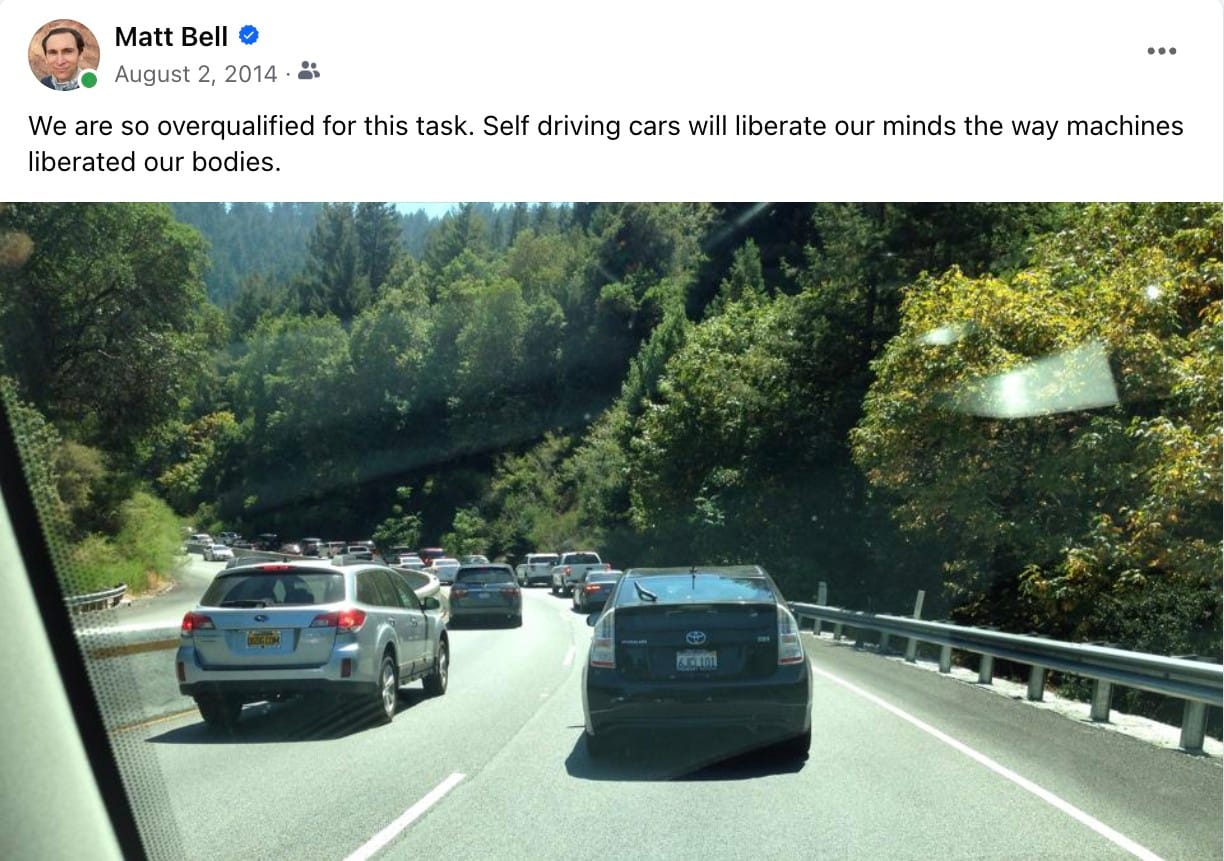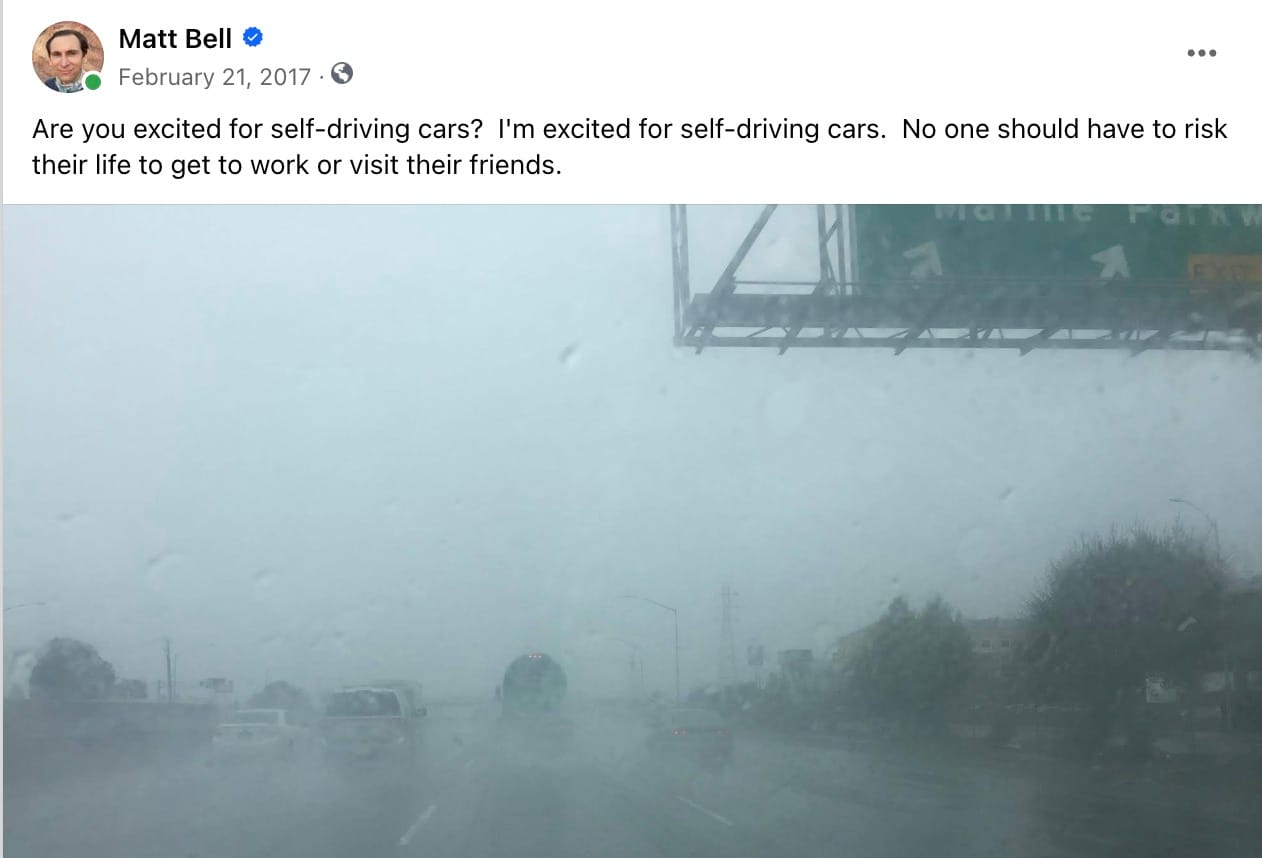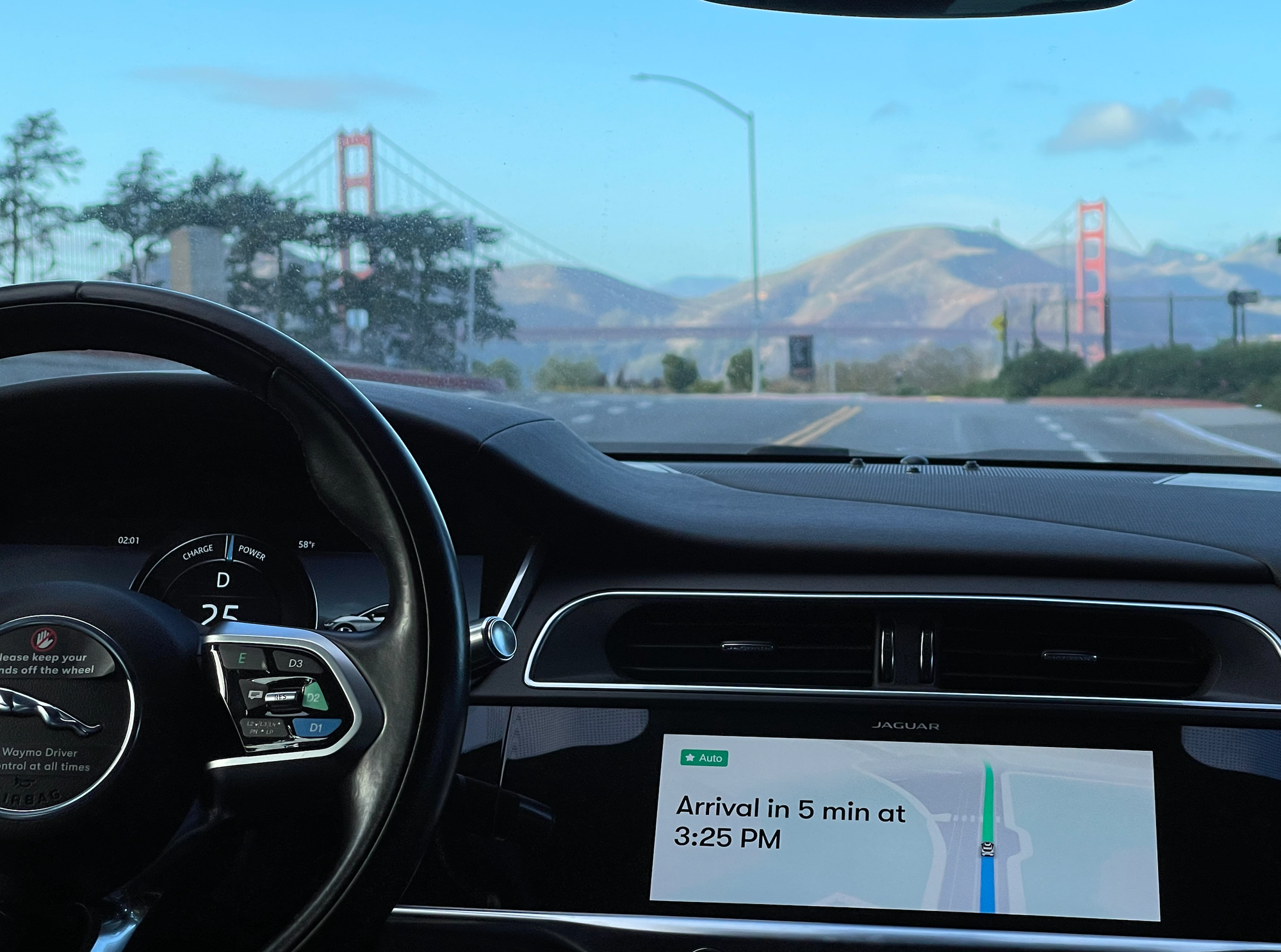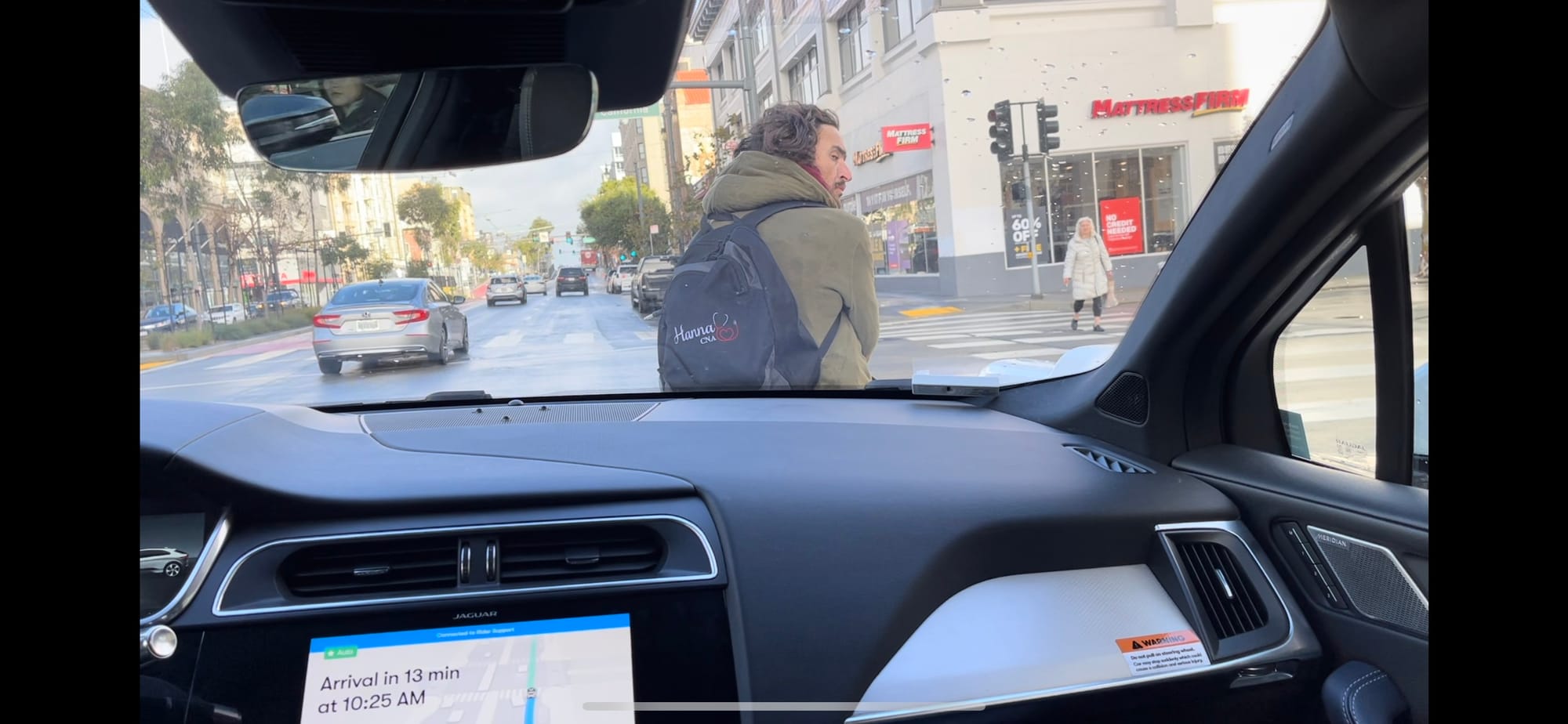
Over the last year I’ve spent over 130 hours in a Waymo. I have used it for my daily commute for much of that year, and I also generally favor it for personal use whenever the wait times are not too long. It’s a revolution in personal transit, and not just for technological reasons. Here’s what I’ve learned.
It’s… boring?


I’ve been waiting for level 5 autonomous driving ever since I first saw Stanford’s Stanley team complete the DARPA Grand Challenge in 2005. I’m not exaggerating when I say that I’ve thought about it and wished for it in every traffic jam I’ve been stuck in. When I took my first ride in September 2023, I was ecstatic, and I watched the car’s internal representation of its world with deep joy and pride. However, by the end of the first ride, I already felt a temptation to stop paying attention and instead get to work on my laptop.
The driving style is smooth and reasonable instead of compulsively rule-following. The car goes at the speed of surrounding traffic instead of obeying the speed limit, and will cross double yellow lines to get around vehicles blocking the road. It’s what you’d expect from a chill and competent human driver.
It’s actually a mobile office
One of the biggest benefits of Waymo is that it’s easy to get work done or take meetings in them. While Lyft and Uber rides are sometimes too bumpy or loud to work in, Waymos are great mobile offices. This is due to the very smooth driving style of the AI and the generous suspension of the car, as well as the predictably quiet environment. You don’t have to worry about annoying the driver by asking them to turn off their radio, which sometimes leads to them giving you bad reviews on Lyft/Uber.
This has a huge impact on my well-being, as it lets me get an extra hour of work done in the time I spend getting to and from work, and that means one more hour of personal or family time at the end of the day. While I love the capacity of mass transit, it’s not a place that is conducive to getting work done for many reasons (noise, lack of privacy, risk of theft).
I expect that Waymo will become especially popular in suburban areas, where commutes are generally 30-45 minutes each way. Most people in knowledge work are not hired for their driving skill, and it makes a lot of sense for their employers to offer Waymo rides as a benefit so that the employees can put their brains to work on their job instead of having them focused on operating a steering wheel.
The ride quality is predictably good
Uber and Lyft have vastly varying quality in vehicles and drivers. The 10th percentile is quite atrocious – I’ve had drivers who were likely on drugs, drivers who seemed one pin drop away from boiling over in rage, drivers who were trying to cover up the cigarette smoke or urine smell in their cars with an equally obnoxious freshener scent, etc. Even the 30th percentile experience is somewhat unpleasant – drivers loudly talking on their cellphones, drivers who get annoyed when you ask them to turn off the ads blaring on the radio or if you don’t engage them in extended conversation on topics of their choice, etc. The 90th percentile Lyft and Uber drivers are lovely – clean cars, friendly without talking your ear off, overall a joyous experience. I still remember gliding over SF’s hilly streets on the way to work at 7am in one immaculately maintained old Scion xB while Tycho’s sunrise album played on the driver's ad-free premium Spotify, but it's memorable for its exceptionality.
The average Waymo is usually at maybe 80th percentile on the Lyft/Uber quality scale. The ride is always smooth, the car environment can be customized to my liking, and I can settle into whatever I’m doing.
Sometimes issues come up during Waymo rides that need addressing (more on that below) but the 10th percentile Waymo ride is still way better than the 10th percentile Lyft/Uber ride.
Predictability of departure and arrival
One of the big issues with Lyft and Uber is that the wait times are very unreliable. They depend entirely on drivers accepting your ride, as well as the drivers being competent and focused on getting to you after accepting the ride. Worse yet, both Lyft and Uber seem to be in an escalating war of lies with their users. When the expected wait time is > 4-5 minutes before booking, the *actual* wait time is often 10+ minutes, and the app sends you dark pattern notifications like “Don’t go away, 6 drivers are looking at your ride right now!”. I’m fairly convinced the countdown timer in the Lyft app to drivers accepting your ride is entirely unmoored from reality and simply designed to prevent you from spinning up an identical request on Uber.
Waymo wait times are often long, but they’re very predictable. There’s no question about whether the car will choose to accept your ride, so the app can predict a wait time that’s correct 90+% of the time. As a result, I’ll often order my morning Waymo before getting dressed, and it arrives at around the time I’m ready to walk out the door. This makes Waymo a much better option than Lyft/Uber when you can plan ahead by 10+ minutes.
I’d love for the Waymo app developers to make “Arrive at Time X” a feature. Then I can just reserve my ride in advance and slot it into my day’s plans.
You’ll feel like a star (at least for the next year or so)

This might be a benefit or a drawback for you personally, but most people have never seen a driverless car before, and they are incredibly compelling to tourists in SF. This means people will constantly be filming you. I once had to meet someone at the Golden Gate Bridge, and the Waymo ride through the Marina and Presidio was like arriving at the red carpet at the Oscars.
Challenges
While I’m an enthusiastic Waymo user, there are still some challenges:
The First/Last Block problem
The Last Mile problem refers to all of the issues that come up when completing the last bit of any service delivery. For example, laying a fiber optic backbone between two cities is an engineering challenge, but getting it from the city center to every house is a tangle of additional logistical challenges and a large fraction of the expense. Delivering a piano to someone’s address is straightforward, but getting it up 4 flights of narrow stairs to their apartment often involves a lot of additional work.
I think Waymo suffers from a similar issue. Lyft & Uber drivers are usually able to sort out how to pick up and drop off riders with ease, but this problem turns out to be rather hard to translate into a fully AI-driven system like Waymo.
This manifests in many ways:
- Waymos can’t yet recognize their passengers, so I’ll often see my ride drive right past me even though I’ve stationed myself in a great spot for it to pull over. Sometimes it will stop in front of me, but will decide for some invisible reason that it isn’t a safe spot to pull over anymore, and it will take off again, leaving me chasing it down and feeling like a chump. This changes the experience from “I’m living in a magical future with robots doing my bidding” to “Hey loser, your ‘shiny’ new tech hates you”. This seems like it would be nontrivial but doable to solve with a combination of gesture recognition and Bluetooth communication.
- On the flip side, it’s hard for pedestrians of other drivers to communicate with a Waymo. If a Waymo stops in front of someone’s driveway while waiting for its passenger, but the owner of the house needs to get their car in or out, there’s no easy way for them (or me, as a rider) to get the car to move. This might be solvable with audio input and output available outside the car, but is difficult to implement in practice and might be abused.
- Waymo does not make it easy for riders to get out early at reasonable stopping points. Sometimes I’m near my destination and want to just hop out and walk the final block because there’s gridlock or because the “final block” involves several blocks of one way streets and I’m running late. There’s a button you can press to ask the car to pull over, but the car has a very conservative idea of safe spots to stop. In contrast, it’s very easy to say “just pull over after you cross the intersection” to a human driver. This seems largely fixable with a combination of adding voice input and some loosened restrictions on what is considered an okay spot to let the passenger out. It’s not clear to me whether I can just open the door when the car is stopped and get out.
Edge cases
There are some scenarios that Waymos aren’t equipped to handle yet. These have ranged from frustrating to hilarious:
- Sometimes Waymos are too polite when a car is blocking the only lane on the street. It will sit there patiently waiting while the driver of the car in front pokes their phone, oblivious to the light turning green.
- There’s a variant of this where there’s a truck double-parked in the right lane of a two-lanes-each-way street, the Waymo is stuck behind it, and there’s smooth traffic flow in the lane to the left. The right thing to do here is to be a bit aggressive in cutting into the lane on the left, but the Waymo is unwilling to take that risk, so I’ve sometimes been stuck this way for a few minutes.
- Waymos stop for jaywalkers, but they can’t tell if someone actually intends to jaywalk or not, and its algorithms are very conservative. I once saw a person who was about to cross the street gesture to the waymo to go ahead, but the car was unwilling to take the risk and unable to recognize the person’s body language, so they engaged in a standoff of politeness until the person eventually crossed the street.
- Waymos sometimes make inexplicable route choices, like doing a complete 360 of right turns around a handful of blocks for no good reason. I don’t have a good explanation for this.
- Once, we were driving past a group of striking workers, and the workers had brought a siren to annoy the management or whoever else was in the building. The Waymo thought the siren was a police siren and pulled over indefinitely. It’s possible I could have resolved this with a call to rider support, but I was only a few blocks from work, so I instead got out of the car and walked the rest of the way. Solving novel scenarios like this one zero-shot is essentially at the level of developing AGI.
The social contract, implicit threats of violence, and the instinct some humans have to bully the defenseless

People are gradually figuring out that Waymos are incredibly docile and careful, and are taking advantage of it. I once had someone sit on my Waymo for a few minutes to prevent it from moving. Waymos are programmed to be very cautious and careful drivers. They are completely unable to deal with someone sitting on the car's hood. This means that any person on the street can indefinitely stall a Waymo. This act in and of itself was a minor annoyance, but I think it's a sign of a new behavioral dynamic that will become a lot more prevalent with time.
The reason this behavior doesn't happen with human-piloted cars is that it's too risky for the person on the street doing the interference. A small fraction of human drivers are prone to violence, and if you're a person on the street looking to stir up trouble, you don't know if you're dealing with a driver who is aggressive or frightened enough to wield a 3000 pound car as a weapon against you. Only a fool or a crazy person would attack or even touch a stranger's car while they're driving it.
Honking (in the US) is often a sign of anger and an implied threat of "I'm the sort of driver who might get upset enough to do something", but Waymos are designed to be exceedingly polite and generally do not honk except in very narrow scenarios. Even if they did honk more often, people would eventually realize that an AI honking is an empty action as opposed to a threat, and treat it as such.
As we create a world with safe, subservient AI systems, human exploitation of them at scale will result in design challenges for the designers of such systems. When is it acceptable for an embodied AI system to take action against someone being obstructive or threatening, especially when the AI system has a human it's protecting? We're just starting to figure this out.
The whole experience with someone sitting on my Waymo also made me realize to what degree the threat of victims fighting back keeps violence down on the streets. Most people buy into the social contract and simply want to go about their day without bothering others, but there are some sociopaths who do not care about harming others in pursuit of their goals, or even actively enjoy it. If the sort of person who wanted to harass others knew they could get away with it every single time (as they can with an AI system), there would be a lot more harassment. However, if their target or a bystander fights back 5% of the time, then there's a deterrent, and the behavior becomes much less common.
Over the last year I’ve seen this desire to harass Waymos crop up in various forms, and from people from all walks of life – a construction worker flashing his stop sign at a Waymo repeatedly to make it stop again and again for fun, a well-dressed middle aged man walking right in front of a Waymo in a busy street because he knew it would slam on the brakes, and a homeless person hovering in front of a Waymo to prevent it from proceeding. At one point a group of people set a Waymo on fire just for the lulz; fortunately this did not happen to me personally.
Resetting the car between riders
It’s surprisingly often that I enter a waymo to the smell of the previous passenger’s farts. A human driver would have rolled down the windows to fix the issue, but Waymos have no way of detecting this proactively. I’ve also been greeted by the previous passenger’s leftover items on the seat or other surprises.

The risk of enshittification
Every new product goes through a series of phases. In the early stages, the company is focused on driving adoption, and works hard to maximize product quality even in its imperfect early state. This is often fueled by venture capital that enables the product or service to be offered at a loss. Over time, as the product becomes more successful and the market becomes more mature and saturated, the opportunities to innovate go down. The hard-driving entrepreneurs move on to new challenges, and the bean-counters take over. The bean-counters look to increase margins not by adding value-added services, but by looking at ways of cutting costs. This hasn’t happened to Waymo yet, but I fear it will show up with time. Maybe they’ll start servicing the interiors less often, or they’ll start showing unskippable un-muteable ads on the control screen like the cabs in Vegas do, or they’ll start skimping on sensor coverage because LIDAR units are expensive.
The bright future
I’m looking forward to the day when Waymo and other Level 5 self-driving options are available nationwide. I think this will result in a radical reorganization of space and people. Currently Waymos are more expensive than human drivers, but once that’s no longer the case, a lot of things will change. This has been explored in great detail by many others so I won’t repeat their work here, but to highlight a few things I’m excited about:
- It’s almost like an increase in life expectancy. Giving people 1-2 hours of their time back per day is an absolutely massive quality of life boost. By replacing 1-2 unproductive hours with 1-2 productive or relaxing hours, we’re functionally extending people’s effective lifespan.
- It’s an actual increase in life expectancy. Everyone knows someone who has been injured or killed in a car accident. Car accidents are one of the leading causes of death for young people, and I’ll be so excited when our streets are safe.
- It’s freedom for kids and the elderly. Many people at both ends of the age spectrum have restricted mobility. Waymo changes that. Kids can get to after-school activities on their own, and older people who can no longer drive at night can still go to events after dark. (If you live in a city and are thinking “what about public transit?”, note that this is often not an option in the suburbs!)
- It’s going to make roadtrips much easier. Live in San Francisco but want to spend Saturday hiking around Mt Whitney? Just go to sleep in your car Friday night, wake up at the trailhead, and spend the day hiking.
- It’s going to lead to some hilarious scenarios, like a drunk person hopping into the car, selecting the wrong saved destination, and passing out, only to wake up 400 miles away in front of their ex’s house. Surprise!
